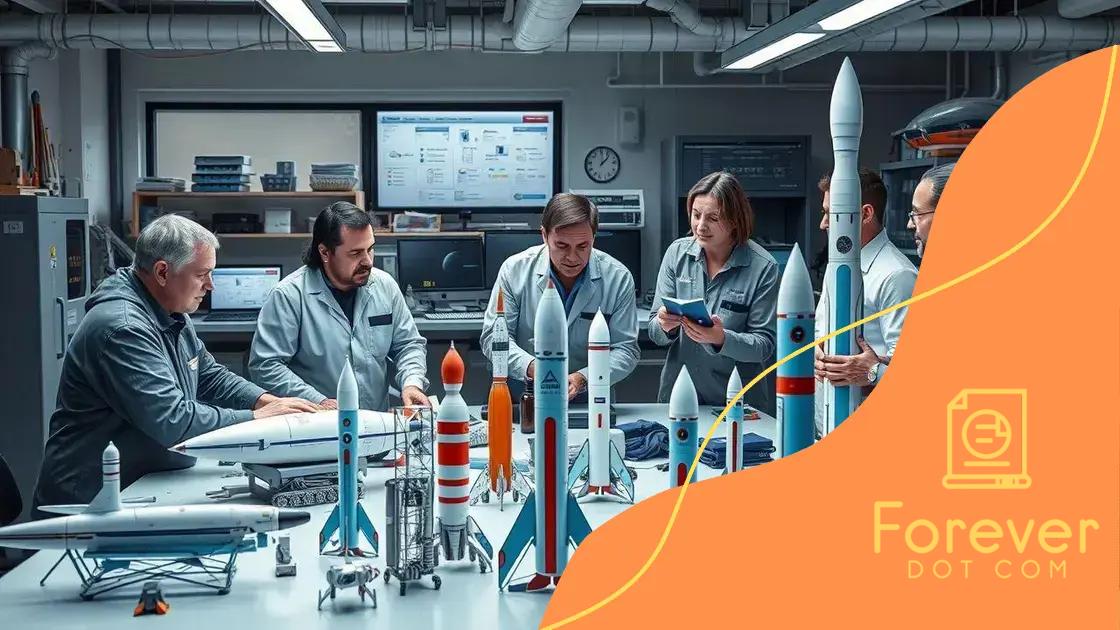The future of space exploration: Private companies lead the way

The future of space exploration relies on private companies leading innovation, with missions to Mars focusing on sustainability and collaboration between public and private sectors to expand our understanding of the universe.
The future of space exploration: private companies lead the way, changing how we view the cosmos. Have you ever wondered what lies beyond our planet? Let’s dive into the exciting developments shaping our interstellar journey.
The rise of private space companies
The rise of private space companies has changed the landscape of space exploration. Over the last decade, we’ve seen these companies innovate and come up with new technologies. They are not just launching satellites; they are paving the way for missions to the Moon and Mars.
One notable example is SpaceX, founded by Elon Musk. They have successfully launched numerous rockets, making space travel more affordable. This has opened up the possibility for more entities to engage in space missions.
Key Players in the Private Space Sector
Several key players have emerged in the private space sector:
- SpaceX: Revolutionizing rocket technology with reusable spacecraft.
- Blue Origin: Focusing on space tourism and orbital missions.
- Virgin Galactic: Pioneering suborbital space tourism experiences.
Each of these companies brings unique approaches that attract investors and interest from governments. As they succeed, they encourage others to enter this exciting field. It’s an arms race of innovation.
Impact on Space Exploration
The impact of these companies on space exploration is profound. Not only are they competing with each other, but they also collaborate. NASA partners with these companies to leverage their technology. For instance, SpaceX is currently contracted to deliver cargo and astronauts to the International Space Station.
Furthermore, the rise of private companies has led to new opportunities for research and exploration. More launches mean more data, which can help us understand our universe better. With this trend, the public is also more engaged, inspiring future generations of scientists and explorers.
In conclusion, the growth of private space companies signifies a turning point in how we explore the universe. With collaboration and a competitive spirit, the possibilities are endless, and the quest for understanding our place in the cosmos continues to evolve.
Innovative technologies changing exploration
Innovative technologies are at the forefront of changing the way we explore space. These advancements not only improve efficiency but also expand our understanding of the universe. Technologies such as artificial intelligence, advanced robotics, and new propulsion systems are transforming missions to other planets.
For example, AI plays a critical role in processing vast amounts of data collected during missions. It helps scientists analyze information and make decisions quickly. This efficiency is vital for exploring distant planets where communication delays can hinder operations.
Key Technologies Leading the Charge
Several key technologies are driving these changes in space exploration:
- Reusable rockets: Companies like SpaceX have developed rockets that can be used multiple times, significantly reducing costs.
- Advanced materials: Lightweight and durable materials make spacecraft more efficient and capable of withstanding harsh conditions in space.
- 3D printing: This technology allows for the on-demand production of parts and tools, reducing the need for costly inventory missions.
These technological advancements do not only enhance exploration but also provide potential for commercial opportunities. They enable new business models and partnerships, encouraging more investment in space ventures.
Future Implications of Technology in Space
The implications of these innovations are vast. As technology continues to develop, missions to the Moon, Mars, and beyond will become more achievable and affordable. The next generation of explorers will benefit from the tools created today, making room for more ambitious missions.
Moreover, the collaboration between private companies and governmental agencies fosters an environment of shared knowledge and innovation. This partnership is essential for achieving goals like establishing a permanent human presence on Mars.
Collaboration between public and private sectors

The collaboration between public and private sectors is transforming space exploration. By working together, these entities leverage each other’s strengths to achieve common goals. This partnership not only boosts innovation but also leads to cost-effective solutions for complex challenges.
Government agencies like NASA have begun to rely on private companies for various missions. For instance, contracts for cargo and crew transportation to the International Space Station (ISS) are awarded to companies like SpaceX and Boeing. This shift allows NASA to focus on deeper space exploration while private companies manage low Earth orbit tasks.
Benefits of Public-Private Partnerships
There are numerous benefits to these partnerships:
- Increased funding: Private investment helps support ambitious projects that may be too costly for public funding alone.
- Innovation: Private companies often bring fresh ideas and cutting-edge technologies.
- Efficiency: Collaboration can streamline processes, reducing timelines for project completions.
Additionally, these partnerships foster a culture of innovation by combining resources and expertise. With both sectors aligned, they can address challenges more effectively, such as developing sustainable technologies for long-duration missions.
Examples of Successful Collaborations
Specific instances showcase the success of these collaborations. For instance, NASA’s Artemis program aims to return humans to the Moon by collaborating with companies like SpaceX and Blue Origin. Each company contributes unique technologies and expertise, creating a collaborative environment.
Similarly, the Lunar Gateway project will see public and private entities working together to build a space station in lunar orbit, which will support future missions to Mars and beyond. This cooperative approach ensures that resources are optimized and that the pace of exploration accelerates.
New missions to Mars and beyond
New missions to Mars and beyond are on the horizon, and they promise to open up a world of possibilities for space exploration. Various space agencies and private companies are planning ambitious missions to explore the Red Planet and further into our solar system.
NASA’s Artemis program is a significant part of this vision, aiming not only to return humans to the Moon but also to use it as a stepping stone for future missions to Mars. As astronauts prepare for these journeys, they will develop technologies and skills necessary for surviving on another planet.
Key Missions Planned for Mars
Several exciting missions are planned for the near future:
- Phoenix Mars Mission: This mission will focus on scouting for water and understanding the Martian climate.
- Sample Return Missions: Several missions aim to collect samples and return them to Earth for detailed analysis.
- Robotic Outposts: Organizations plan to establish robotic outposts on Mars to gather data and assess the planet’s environment.
These missions will provide crucial information to address many questions about Mars, including the potential for past life and the best sites for human exploration.
The Future of Human Exploration
Exploring beyond Mars to moons like Europa and Ganymede is also part of the long-term vision. These moons are thought to have subsurface oceans, raising the possibility of extraterrestrial life. Their exploration could reveal significant insights into our understanding of life beyond Earth.
Collaboration between public and private sectors is essential for these ventures. Companies like SpaceX are developing spacecraft capable of transporting humans to Mars, while NASA focuses on the scientific goals of these missions. As the technologies evolve, the dream of human colonization on Mars is becoming increasingly plausible.
Sustainability in space travel
Sustainability in space travel is becoming increasingly important as we aim for long-term exploration beyond Earth. As missions to planets, moons, and asteroids are planned, we must consider how to minimize our impact on these celestial bodies.
Developing sustainable technologies can help us protect the environments we explore. For instance, using renewable energy sources, recycling materials, and creating closed-loop systems are steps toward reducing waste in space.
Key Sustainable Practices in Space Exploration
Several sustainable practices are emerging in space exploration:
- In-situ resource utilization (ISRU): This technique involves using resources found on other planets for fuel, water, and food. For example, extracting water from the lunar surface can support human life during missions.
- Energy efficiency: Developing energy-efficient spacecraft can reduce the amount of fuel needed for long journeys.
- Waste recycling: Recycling waste created during missions can help minimize pollution and conserve resources.
These practices not only help sustain our space missions but also reflect responsible stewardship of other worlds. By implementing these methods, we can preserve the environments we explore for future generations.
The Importance of Sustainability
Adopting sustainable practices is essential for the future of humanity in space. As we establish a presence on other celestial bodies, we must ensure that we do not harm them. This ensures that we can continue to explore and learn without causing irreversible damage.
Sustainability also drives innovation. By developing new technologies to create self-sustaining systems, we can make space travel more feasible and efficient. These innovations could lead to breakthroughs that benefit life on Earth, such as advancements in recycling and energy-efficient technologies.
As we continue to explore space, it is crucial to embrace innovation and sustainability. With private companies leading the charge and public sectors collaborating, we have unprecedented opportunities to advance our understanding of the universe. Missions to Mars and beyond will help us discover new worlds and learn more about our own planet. By prioritizing sustainable practices, we can ensure that future generations enjoy the wonders of space exploration without damaging the environments we explore. Together, we can make space travel safe, efficient, and responsible.
FAQ – Frequently Asked Questions about Space Exploration
What role do private companies play in space exploration?
Private companies are leading the charge in innovation and technology, partnering with government agencies to conduct missions to space.
How is sustainability integrated into space travel?
Sustainability is emphasized through practices like using renewable resources, recycling materials, and developing in-situ resource utilization techniques.
What are some upcoming missions to Mars?
Upcoming missions include sample return missions, robotic outposts, and collaborations between NASA and private companies aimed at human exploration.
Why is collaboration between public and private sectors important?
Collaboration allows for shared resources, expertise, and funding, which enhances the success rate of complex space missions.






